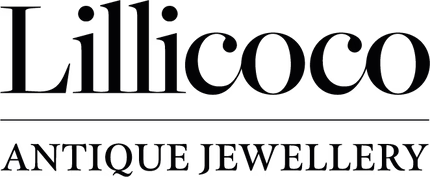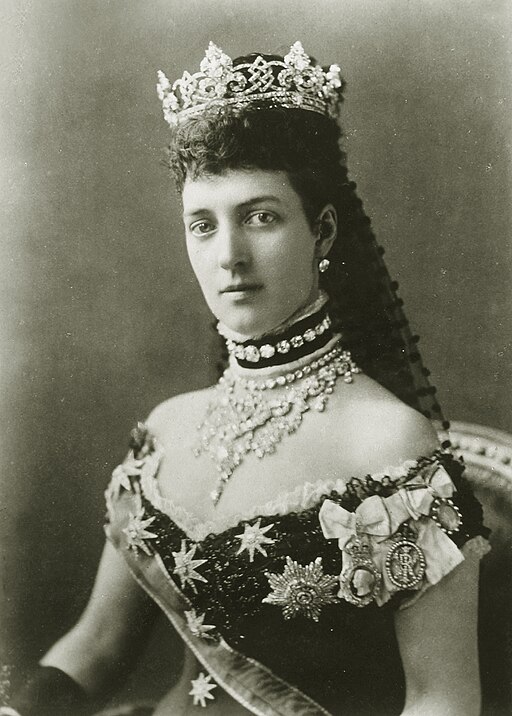After Queen Victoria’s death, her eldest son Prince Edward VII immediately ascended to the throne. His brief reign lasted only nine years (1901 to 1910) but the Edwardian era is seen by most historians to include both his tenure as Prince of Wales (starting from 1880 when he rose to popularity given Queen Victoria’s absence from the public) until the start of the First World War in 1914.
Although the Edwardian Era was relatively short-lived, it has become widely known as the years when arts and crafts flourished in Britain. (See Arts and Crafts Movement). This is also the last British era to be named after the reigning monarch of the time.
Differences Between Victorian and Edwardian Periods
King Edward, prior to his reign, cultivated a reputation that is in many respects the polar opposite of his mother’s. He was known to gamble and led a playboy lifestyle. Before and during his wedding to the Princess Alexandra of Denmark, Edward had multiple mistresses. His scandals even included citations in two divorce cases.
He also had a taste for the luxurious, which helped shaped this era’s jewellery designs and fashion trends. His influences began at the tail-end of the Victorian era and extended well into the First World War (what was at the time referred to as the Great War) — a testament to how popular and influential he was.
After he took over, Edward renovated royal palaces to reflect his era’s fashion style and rival the courts in Germany and Russia, having the Ritz Hotel designers go to work on Buckingham Palace. He also restarted traditional ceremonies that Queen Victoria stopped doing and founded new honours especially for those who contributed to the arts and sciences.
Morals were laxer during Edward’s reign, which was a stark contrast to Victorian conservativeness. Inventions were implemented and became more widely used. During this time, plenty of British homes were equipped with electricity, plumbing and phones. To those who could afford it, motor cars became available for the first time.
During his reign, King Edward managed to foster good international relations with neighbouring European countries, most notably with Britain’s traditional enemy, France. This earned him the title “Peacemaker”.
Socio-Political Aspects of the Edwardian Era
British society changed alongside the Western world, in terms of socio-political developments. The status and luxuries of the elite were solidified, making the Edwardian era an opulent one. Although sports and other forms of play gained traction in Victorian times, the Edwardian era brought them to international heights. The Olympics were first held in England in 1908, for example.
Income was almost tax-free, the arts flourished, and travel was more accessible as only the Russian and Ottoman borders required visas. The British people witnessed further evolution and implementation of technology such as the growth of electricity and communication technology like the telephone.
The judiciary and executive branches ruled against child labour, treating it as a severe offence. Education became mandatory for all children. However, poverty continued to pervade the working class, with 23% of those in urban working households living with insufficient income.

Civil rights and anti-imperial movements were commonplace during this era. Conquest was losing popularity and was constantly challenged, with the outcome of the Boer Wars exposing Britain’s weakening military dominance. As a result of shifting geopolitics in Europe, King Edward formed an alliance with France and Russia to counterbalance the Triple Alliance of Germany, Austria and Italy, setting the stage for the First World War.
The fight for women’s equality further advanced, as they shed the passivity that marked the Victorian era. Proponents caused civil disobedience and were jailed. Although the right to suffrage was only granted in 1918, the British people saw a more aggressive resistance from women’s groups during the Edwardian era. There was also a growing number of educated women who took part in politics and social causes.
Edwardian Architecture
Edwardian architecture was less ornate than that of the Victorian era. The Edwardian Baroque style is the only exception, as it is characterised by rustication, domed corner rooftops, and colonnades, among other features. Often used for public buildings, this style also coincides with the Art Nouveau movement.
The Old War Office in London, designed in the Edwardian Baroque style.

There was a huge housing boom during this era, as the growing middle class was able to afford decreasing mortgage prices. Railway lines made the suburbs (where properties cost less) more accessible.
Edwardian architects and designers used lighter colours, given that there was no more need to disguise soot build-ups in walls, thanks to the advent of electricity as a source of power. Less complex patterns were favoured, as well as red bricks and leaded glass doors.
Houses had fewer rooms than Victorian ones, as the need for house staff diminished. Airy rooms and larger houses on wider plots were in vogue; porches were a must, regardless of societal status; and exterior facades (e.g. gardens, verandas) were given importance.
An Edwardian style home.

Edwardian Fashion
King Edward and Queen Alexandra’s tastes set the trends for this era’s fashion. British high society and the middle class followed their King’s lavish lifestyle.
Women’s Clothing
This era dropped the heavy fabrics and sombre colours that the Victorians espoused. The hourglass shape also disappeared, as the “S” curve became more popular. This was achieved by using a less constrictive corset, which gave women an elongated silhouette with a monobosom (a pigeon-like appearance).
A dress styled to give women the “S” curve.

“The Gibson Girl” personified the ideal woman during the Edwardian era. Illustrated by American graphic artist Charles Dana Gibson, she is described to be fun loving, sophisticated, strong, and youthful. She is also slender with an ample bosom and hips, a small waist, and hair piled high on her head.

Camilla Antoinette Clifford, a Belgian-born stage actress, was the ‘quintessential Gibson Girl’ image. She often wore long, elegant gowns and tight corsets that gave her an 18-inch waist.
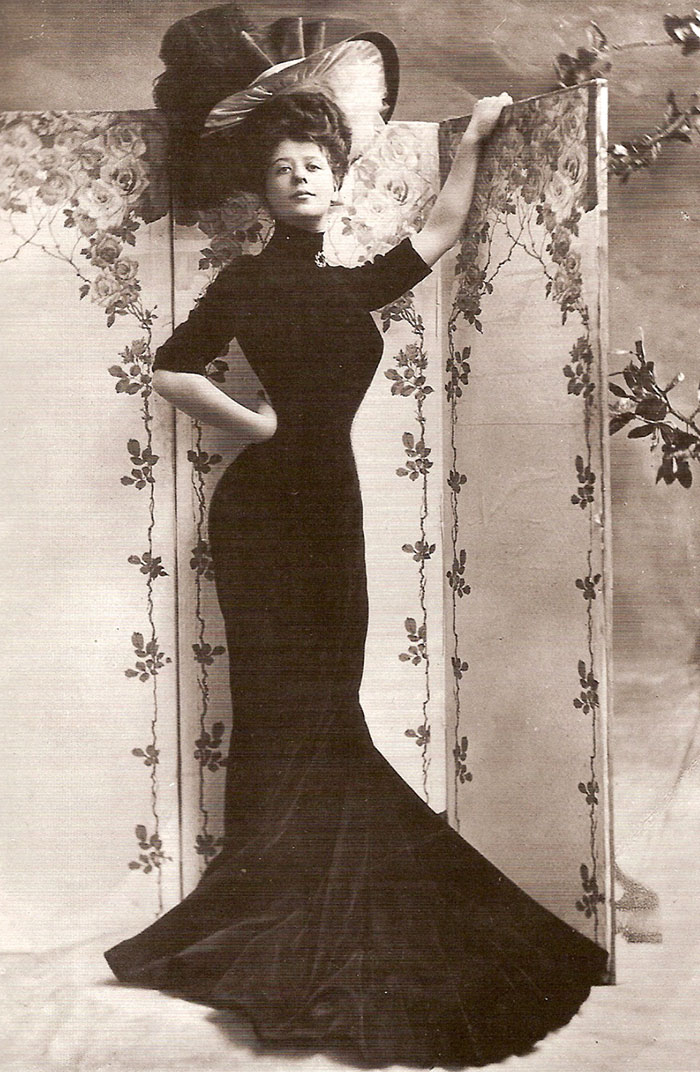
As time went by, fashion evolved. Hemlines and necklines changed, waistlines rose, and lingerie dresses (tea gowns with ruffles and lace) were worn indoors. Wide-brimmed hats with feather trimmings were also popular, as well as lace-up boots.
Edwardian era tea gowns for indoor wear.

Towards the end of this period, women swapped the “S” curve for straight tube sheath dresses, which accommodated their more active lifestyle. Tailored dresses were worn for outdoor activities. Dressed then had more straight lines and less structure involved, so women can easily move.
Oriental influences were also evident, with turbans and jewelled slippers giving the exotic ingredient in Western styles. The start of the First World War effectively put an end to opulent fashion, as materials became harder to come by.
Men’s Clothing
Men’s clothing, on the other hand, remained the same. Slim and tightly fitted looks stayed popular. Men also prefer dark colours, be it for day or evening wear, although formal events still call for luxurious styling. Hats, bow tie and/or neckties completed their attire. There was, however, a huge demand for sports apparel, as interests in these activities boomed.
Edwardian clothing style for men.

Edwardian Arts
The Edwardian era coincides with France’s Belle Epoque era, which means the Art Nouveau style influenced artistic endeavours during King Edward’s reign. Technological innovations and increasing awareness of societal woes also played their parts in artistic works.
The Peter Pan statue in Kensington Gardens, which inspired author J.M. Barrie.

Literature focused on both children and adults (as opposed to the Victorian era’s adult-driven fictions). However, children and adults in books were often separated, as in the cases of Peter Pan (J.M. Barrie)and Alice in Wonderland (Lewis Carroll). There was also less realism involved. Among other notable names include George Bernard Shaw, Rudyard Kipling, and James Joyce.
Music and the performing arts continued to flourish. People flocked live performances, as cinema was still in its nascent years.
Edwardian Jewellery
Towards the end of the Victorian era, then-prince Edward and his wife Alexandra rose in status as one of the fashionable elites. The Industrial Revolution, which had begun during Victoria’s reign, allowed for Edwardian jewellery to be mass produced which made it available to the wider populace.
After his coronation, King Edward threw many formal events at Buckingham Palace that increased jewellery demand among the nobility but these, unfortunately, came to an abrupt end with to the onset of the First World War.
There was a lighthearted tone in Edwardian styles, including their jewellery. The light and airy look dominated, even with the designs of mourning pieces that followed the Titanic’s sinking.
18th-century traditions
Queen Alexandra wearing one of her signature collier de Chien necklaces.
Source: https://en.wikipedia.org/wiki/Alexandra_of_Denmark
King Edward’s lavish soirees, court presentations, and formal balls encouraged members of the noble families to unabashedly display copious amount of material wealth, especially since jewellery was very much a status symbol at the time.
Many designers of this era took inspiration from 18th-century traditions, particularly the use of precious stones like diamonds and Pearls in pieces like tiaras and necklaces.
Queen Alexandra was also fond of colliers de Chien or dog collars. These were usually designed either with a ribbon and a brooch or as several pearls strung together.
Interestingly, Pearls were considered more valuable than diamonds in this era as fine quality, large specimens were only available from exotic, far-away places such as Australia and off the coast of Africa and were extremely costly.
Working class jewellery
Technology made jewellery available for purchase by the general public. Although most of the pieces were luxurious and pricey, both the middle and working classes were able to buy simpler, more affordable counterparts. As such, brooches, gypsy earrings, and simple bangles became popular. Manufacturers cut costs by using prepared gold instead of platinum.
Popular materials

Cartier introduced the practice of using platinum for jewellery pieces during this era. Given that it’s not as malleable as gold, there was less platinum needed to create a strong setting. This technique then gave rise to the white-on-white look, making the stones look like they were floating on the wearer’s skin.

Pendants

Pendants in this era were created using gold alloy, Diamonds, pearls, or platinum, often worn by high society. Some of them were heavily decorated, while some sport a simpler and more delicate design.
Popular styles include solitaire or two chains hanging from a central point. White gold alloy was used as the alternative to platinum necklaces. Heart-shaped pendants were given as romantic gifts.
Queen Alexandra’s tastes also influenced pendant styles, as her fondness for Indian jewellery made its way to Edwardian designs.
Brooches

Although Victorian brooches were also luxurious, Edwardian jewellery had a more romantic, light, and whimsical feel. Both affluent socialites and the working class wore brooches to accessorise their outfits, whether they were made from gold, pearls, or diamonds.
Earrings

Although technology made mass production possible, craftsmen were still in demand given the unique jewellery they could create. Similar to other pieces, earrings were often adorned with pearls and diamonds, as well as other precious stones.
The teardrop style (a long string of diamonds often ending with a pearl) were in vogue, as well as chandelier-type earrings. These earrings were designed with grace and elegance in mind and were often very feminine in nature.

Shapes and patterns

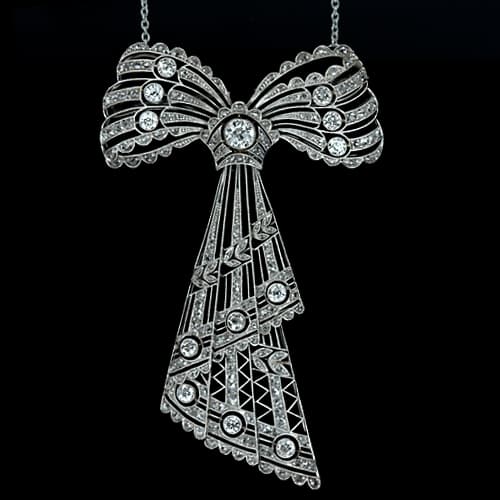
As with any era, styles evolved. Thanks to the rising use of platinum (a much easier metal to manipulate), people started to be drawn to delicate jewellery crafted into designs that were not seen as often before. These included knots, bows, wreaths, and ribbons, which were then applied to pieces including rings, tiaras, and necklaces.
Notable Designers in Edwardian Jewellery
There were plenty of notable jewellers that came to fame in the Edwardian era and made their mark on the industry, including Boucheron, Asprey, Garrard, and Carrington. Notably, the De Beers Consolidated Land Mines opened in 1888, a few years before King Edward was crowned, enabling an increase in the production of diamond jewellery.
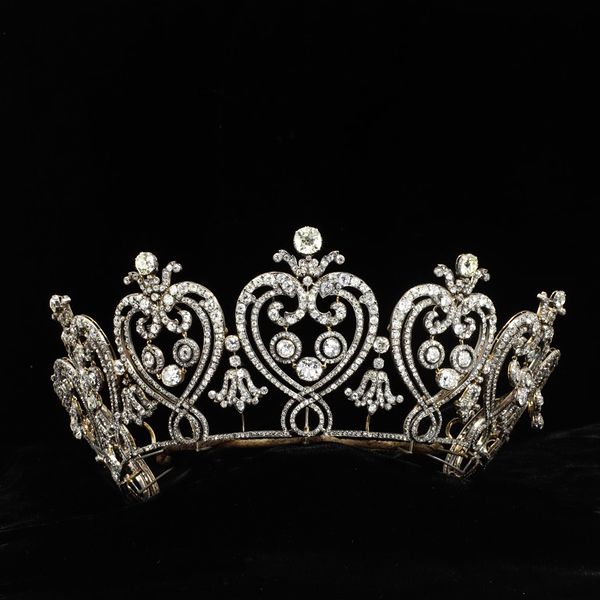
However, one name stands out above the rest, and that is Louis Cartier. The house of Cartier opened in London in the 1850s, but they became a household name during the Edwardian era when the King named them his official jeweller. Cartier was said to encourage his designers to walk down the streets and take inspiration from 18th-century architecture, which resulted in delicate and richly ornamented pieces.
The Great War and the End of an Era
The opulent lifestyle of the Edwardian era (amongst the middle classes at least) was put to an abrupt end when the First World War began in 1914, making raw materials harder to come by. Platinum was replaced by white-gold alloy, decreasing the value of the jewellery being produced. There was also a significant downturn in the number of formal events taking place.
Although marked by frivolity, in stark contrast to his mother’s morally conservative reign, King Edward’s era marked significant shifts in fashion and various art forms as Britain entered a post-industrial world. Despite his short tenure, Edward himself became a popular monarch whose influence on fashion and art lived on well after his death in 1910.




